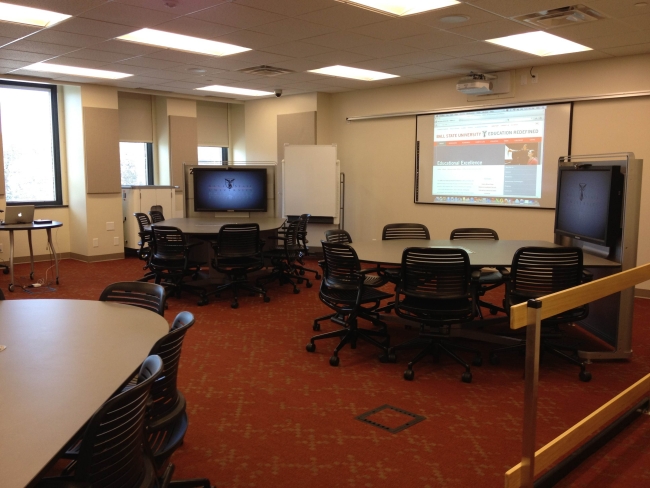You have /5 articles left.
Sign up for a free account or log in.

Ball State University
Ball State University is using active learning, multimedia-enabled classrooms and swivel chairs to put a new spin on its faculty development efforts.
The university earlier this decade renovated its Teachers College building, creating two classrooms it calls Interactive Learning Spaces. The rooms are part of a larger faculty development program intended to promote active learning techniques and cut down on lecturing. As the program has expanded, the university is researching whether teaching at-risk students -- those withdrawing from or earning a D or F in a basic math course -- in the classrooms could improve academic outcomes and, eventually, graduation rates.
 “Universities obviously are all going through the same difficult financial straits, and for a university that is considered mid-major like Ball State, [creating experimental classrooms] is a financial strain,” said Gary M. Pavlechko, director of teaching technology in the office of educational excellence. “We know that we’re in competition with other schools not only in Indiana but here in the Midwest. How do we set ourselves apart? In our case, by the development of these interactive learning space classrooms, we are demonstrating to everyone that we are committed to the concept of faculty development.”
“Universities obviously are all going through the same difficult financial straits, and for a university that is considered mid-major like Ball State, [creating experimental classrooms] is a financial strain,” said Gary M. Pavlechko, director of teaching technology in the office of educational excellence. “We know that we’re in competition with other schools not only in Indiana but here in the Midwest. How do we set ourselves apart? In our case, by the development of these interactive learning space classrooms, we are demonstrating to everyone that we are committed to the concept of faculty development.”
Both classrooms seat 24 students but use different layouts. One room has students create groups of six around tables with flat screens that allow students to hook up their devices and quickly share content with others. Another consists of swivel chairs with built-in desks that enable students to roll around the classroom and form groups on the fly. Both rooms also lack a logical “front,” so faculty members are encouraged to walk among students as they work together.
Ball State's initiative may sound like the in-class part of a flipped course, but none of the instruction in the courses is actually moved outside the classroom. Instead, the university hopes changing the way the instruction is delivered will encourage students to be more engaged and therefore make them more likely to perform well.
Pavlechko described the two spaces as “intake classrooms” -- faculty members who work in the development program are required to teach in them for two semesters. By the end of this academic year, the classrooms will have hosted 68 faculty members representing 29 of the university’s 48 departments and more than 3,500 students.
Next fall, Ball State will expand the program and open a 40-seat and a 72-seat room so faculty members teaching larger classes -- such as an introductory psychology course -- can use the new facilities. The university plans to spend about $230,000 on those spaces, excluding construction costs. The two smaller classrooms averaged about $90,000, Pavlechko said.
“We’re just lucky that we have that type of administrative support that understands how you sustain a program like ours and where it’s going to make a significant difference over an extended period of time,” Pavlechko said. “We are not one-workshop wonders or of that belief.”
The classrooms have also given researchers at Ball State an opportunity to test the effect of different pedagogies, but whether the classrooms actually improve student outcomes is still unsettled.
“We actually found a fairly moderate to strong correlation between what they think of these areas and if they think they have the ability to get a higher grade -- or their motivation to attend class and also their engagement in class,” said Jim Jones, director of the office of research and academic effectiveness. “When we try to get more to the heart of it, we’re getting more mixed results.”
Steelcase, the office furniture provider Ball State worked with on the new classrooms, has produced similar results. The company has surveyed hundreds of students and faculty members at the universities it has worked with, and says it has found a statistically significant correlation between classroom configuration and student engagement. The survey doesn't include any academic results.
Students at Ball State believed they were more likely to attend class, engage with their classmates and finish with better grades, but their academic results haven’t necessarily matched their enthusiasm.
The results from students in the basic math class were the most promising. After controlling for demographics and academic backgrounds, researchers found at-risk students who took the course in classrooms that promoted active learning (which included some rooms other than the renovated ones) were 2.8 times more likely to succeed -- that is, to earn a grade higher than a D -- than students in traditional classrooms.
While those results suggest at-risk students may benefit from that new classrooms, other tests have produced less conclusive results. In one early pilot test, students attending classes in the renovated classrooms performed 0.19 points of a letter grade better than students in traditional classrooms. When the pilot later expanded to 24 sections -- 12 in the new classrooms, 12 in the old -- “the overall results on grades kind of canceled each other out,” Jones said.
In many of the comparisons, Jones said, students in the classrooms that promoted active learning earned grades that on average were about 0.2 points of a letter grade higher, but some “really weird extremes” on both ends of the scale made it difficult to draw any conclusions. The researchers suspect individual faculty members or a small sample size may be to blame, and hope more data will clear it up.
“Perception-wise, students are telling us ‘I can do better when I’m in these spaces,’ ” Jones said. “Maybe that’s enough of a win?”





